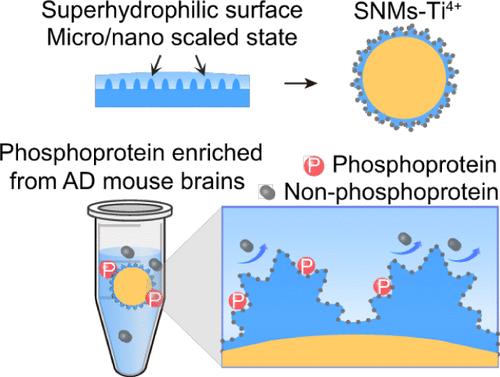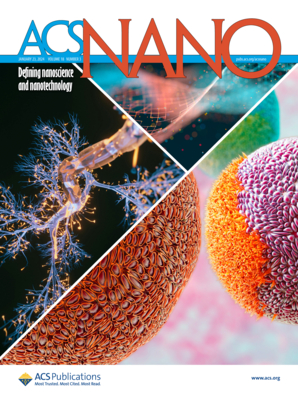Superhydrophilic Nanostructured Microparticles for Enhanced Phosphoprotein Enrichment from Alzheimer’s Disease Brain
IF 15.8
1区 材料科学
Q1 CHEMISTRY, MULTIDISCIPLINARY
引用次数: 0
Abstract
Alzheimer’s disease (AD) is an incurable neurodegenerative disorder and closely related to abnormal phosphoproteoforms. The analysis of low-abundance phosphoproteoforms relies heavily on the enrichment of phosphoproteins. However, existing phosphoprotein enrichment materials suffer from either low selectivity or low coverage due to the unavoidable unspecific adsorption of background proteins. Here, we propose a strategy of nanostructure-enabled superhydrophilic surfaces and synthesize Ti4+-functionalized superhydrophilic nanostructured microparticles (SNMs-Ti4+) via an emulsion interfacial polymerization process. In this process, hydrophilic and hydrophobic monomers assemble into a stable oil-in-water emulsion, producing microparticles with abundant hydrophilic phosphate nanoprotrusions on the surface. The microparticles are subsequently functionalized with Ti4+. SNMs-Ti4+ exhibit enormous nanoprotrusions and abundant Ti4+ modifications, which allow SNMs-Ti4+ to effectively adsorb the phosphoproteins and suppress the unspecific adsorption of background proteins. Using these SNMs-Ti4+, we identified 2256 phosphoproteins from HeLa cells, twice the number of those enriched with commercial kits. From AD mouse brains, 2603 phosphoproteins were successfully enriched, and 10 times of AD-related differentially regulated phosphoproteins were discovered than those without enrichment. These microparticles show great prospects for biomarker detection, disease diagnosis, and downstream biological process disclosure.

求助全文
约1分钟内获得全文
求助全文
来源期刊

ACS Nano
工程技术-材料科学:综合
CiteScore
26.00
自引率
4.10%
发文量
1627
审稿时长
1.7 months
期刊介绍:
ACS Nano, published monthly, serves as an international forum for comprehensive articles on nanoscience and nanotechnology research at the intersections of chemistry, biology, materials science, physics, and engineering. The journal fosters communication among scientists in these communities, facilitating collaboration, new research opportunities, and advancements through discoveries. ACS Nano covers synthesis, assembly, characterization, theory, and simulation of nanostructures, nanobiotechnology, nanofabrication, methods and tools for nanoscience and nanotechnology, and self- and directed-assembly. Alongside original research articles, it offers thorough reviews, perspectives on cutting-edge research, and discussions envisioning the future of nanoscience and nanotechnology.
 求助内容:
求助内容: 应助结果提醒方式:
应助结果提醒方式:


